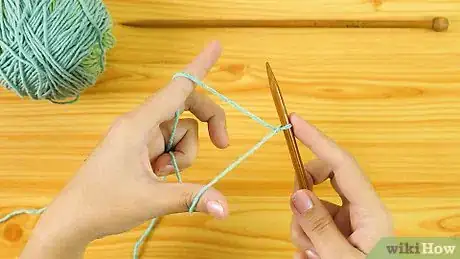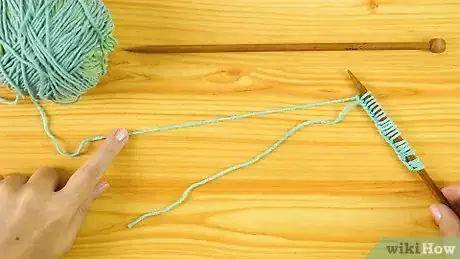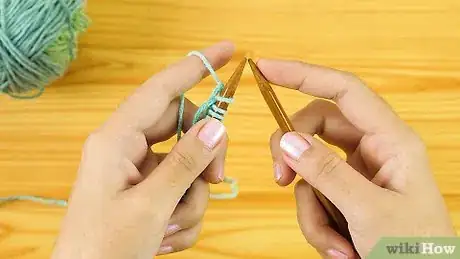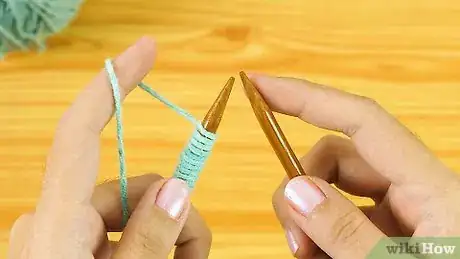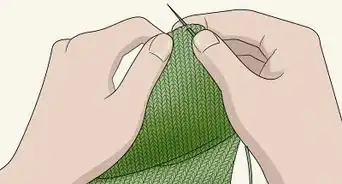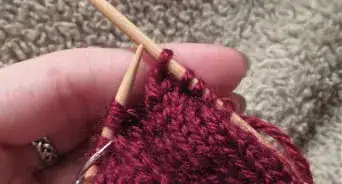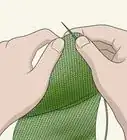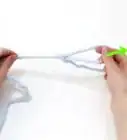This article was co-authored by wikiHow Staff. Our trained team of editors and researchers validate articles for accuracy and comprehensiveness. wikiHow's Content Management Team carefully monitors the work from our editorial staff to ensure that each article is backed by trusted research and meets our high quality standards.
The wikiHow Video Team also followed the article's instructions and verified that they work.
This article has been viewed 122,317 times.
Learn more...
Ribbing adds stretch to a knitted item, and makes it look more interesting too. If you can purl, you can easily learn to knit the ribstitch. To knit ribbing, you should first cast on. From there, learn how to do a knit stitch, then a purl stitch. Alternate between knitting and purling to create a fun ribbed stitch.
Steps
Preparing Your Yarn and Needles
-
1Make a triangular shape with the yarn using your fingers. Use your left hand. Pull a bit of yarn out of your ball. Hang the yarn over your thumb and index finger, with the tail end dangling off your thumb and the end attached to the yarn ball hanging over your index finger. Make sure you have at least a foot of extra yarn hanging from your thumb.[1]
- Use your remaining fingers to grasp the two strands of yarn and hold them together.
- The yarn should make a triangular shape with points at your thumb, your index finger, and the remaining fingers holding the strands of yarn together.
-
2Cast on. Take a needle. Using your right hand, put the needle under the string held between your thumb and index finger. Secure the yarn to the needle by pressing down on it with your right index finger. Pull the yarn downward, away from your left thumb and index finger. This should make a slight indent in your triangle.[2]
- Pass the needle over the strand of thread between your thumb and index finger, slightly looping this strand onto the needle. It's very important you move your needle over this strand of yarn and not under it. From here, move the tip of the needle towards your thumb.
- Keep pulling the needle and thread downward towards the base of your thumb. A loop of yarn should form around your thumb. Another loop should form around your index finger.
- Push the tip of the needle through the thumb loop. The tip of the needle should pass underneath the yarn, and not over the yarn. Now, move the needle towards the loop of yarn on your index finger. Pass the tip of the needle over the loop on your index finger. It's important the needle goes over this loop, and not under it. Remember, your needle goes under the loop on your thumb, and then over the loop on your index finger.
- Once you've passed the needle over the loop on your index finger, move the needle back towards your thumb. Continue moving the needle forward until it passes underneath the thumb loop.
- Release the thumb loop. Pull down on the yarn released from the thumb loop to tighten the stitch you've created. You should now have one stitch securely wrapped around your needle.
Advertisement -
3Add your desired number of stitches to your needle. You'll add stitches by creating a triangle similar to the one you began with. The tail end of the yarn will hang over your thumb. The end attached to the ball of yarn will hang over your index finger. However, you do not need to grasp the ends together this time. They are attached by the needle. The needle takes the place held by your remaining fingers when you were casting on.[3]
- Move the needle downward. A loop of yarn should form around your thumb and index finger.
- Pass the needle underneath the thumb loop. Then, move the needle towards the index finger loop. Pass it over this loop and, once again, move the needle back towards the thumb until it passes under the thumb loop.
- Release the thumb loop and pull the yarn released to tighten. You have added one stitch. Repeat this process until you've added as many stitches as you want. It's a good idea to use an even number of stitches when knitting ribbing.
-
4Identify the working yarn versus the tail yarn. The working yarn refers to the yarn still attached to the ball. The tail yarn is the end of the yarn, unattached to the ball. When knitting or purling, only use the the working yarn as you add to the project. The tail yarn will be tied into a knot when you finish knitting and the tail end of it will be snipped off.
Doing a Knit Stitch
-
1Grasp your needles. To start, hold your needles. One needle should contain all the stitches. The other needle should be bare. Hold the bare needle in your right hand. Hold the stitched needle in your left hand.[4]
-
2Place the bare needle through the first stitch on the stitched needle. You'll start by working with the stitch nearest the tip of stitched needle. The stitches form tiny circular loops around the needle. You will want to pass the bare needle through the bottom of this loop.[5]
- To knit, you will want to enter the stitch from the front. This means, you should enter the stitch on the side of the needle facing you. You also want to put the tip of bare the needle between the front stitch and the stitch just behind the front stitch. Do not place the bare needle's tip between the front stitch and the tip of the stitched needle.
- Once you have the positioning correct, push the tip of the needle through this stitch. Move about a half an inch's worth of the bare needle through the stitch and then stop.
-
3Wrap the working yarn clockwise around the bare needle. Now, grab your working yarn with your right hand. You're going to wrap the working yarn around the tip of the bare needle. Wrap the yarn around the bare needle and over the stitched needle. Make sure to wrap the working yarn clockwise. Do not wrap the yarn counter clockwise. The loop should form around the back of the bare needle.[6]
-
4Move the stitched needle over the bare needle. The two needles should now be somewhat secured together with the working yarn, forming a roughly ninety degree angle. One loop of yarn should be formed around the bare needle. Use your right hand to pull down on the working yarn, preventing this loop from coming undone.
- Use your left hand to slowly move the stitched needle upward.
- Pass it over the tip of the bare needle.
- As you do this, simultaneously pass the tip of the bare needle through the first stitch on the stitched needle.
- Make sure you point the bare needle inward. The bare needle's tip should be pointing towards the other stitches as it passes through the first stitch.
-
5Transfer the stitch to the bare needle. Now, you'll be transferring the stitch from the stitched needle to the bare needle. Hold the other stitches in place with your left index finger. Gently slide the bare needle forward, taking the first stitch with you. Keep sliding until the needles separate again, with one stitch now on the bare needle.[7]
- If you're new to knitting, you'll have to move slowly throughout this process. As you become more adept at knitting, you'll find you can move through it swiftly.
Doing a Purl Stitch
-
1Get ahold of your needles. To purl, pick up your needles again. You should hold the stitched needle in your left hand and the bare needle in your right hand.
-
2Place the bare needle through the back of the first stitch on the stitched needle. Purling is essentially the opposite of knitting. To start, you'll be pushing the bare needle through the back of the first stitch rather than through the front.[8]
- Take the tip of the bare needle and place it behind the stitched needle. The bare needle should enter the first stitch on the side of the stitches not facing you.
- You will also enter the stitch differently. Place the bare needle's tip between the front stitch and the tip of the stitched needle. Do not put the tip of bare the needle between the front stitch and the stitch just behind the front stitch.
- Once the positioning is correct, push the tip of the bare needle through the loop formed by the first stitch. Push about half an inch of the bare needle through the stitch.
-
3Wrap the working yarn counter clockwise around the bare needle. Take the working yarn with your right hand. Move the yarn around the bare needle and over the stitched needle. The yarn should be pulled counter clockwise this time, looping the yarn around the front of the bare needle rather than the back.[9]
-
4Move the stitched needle over the bare needle. The process from here is similar to knitting. Secure the loop on the bare needle by using your right hand to hold the working thread down. Slowly move the stitched needle over the tip of the bare needle.[10]
- Once again, make sure to pass the bare needle through the loop formed by the first stitch as you pass the needles over one another.
-
5Transfer the stitch to the bare needle. Holding the remaining stitches down with your left hand, gently slide the bare needle forward. Keep sliding until the first stitch transfers to the bare needle. The needles should be separated now, with one stitch on the bare needle.[11]
Creating a Ribbing Pattern
-
1Knit one stitch. Ribbing creates a pattern by alternating between knitting and purling. To start ribbing, knit one stitch. If you're new to knitting, go slowly. You want to make sure you knit the stitch correctly as not to mess up your pattern.[12]
-
2Loop your yarn over the needle. As purling requires a different starting point than knitting, you'll have to adjust your yarn after you knit the first stitch. To do so, take the working yarn with your right hand. The working yarn should be on the right side of the bare needle. Take the working yarn and pass it behind the bare needle to transfer it to the left side.[13]
- Make sure to transfer the thread every time. Otherwise, you will be unable to purl correctly.
-
3Purl one stitch. From here, purl one stitch. Work slowly if you're new to purling to avoid screwing up the pattern. You'll have to move the thread again when you finish purling. You can move the thread from the left to the right side, passing it behind the bare needle.[14]
-
4Alternate between knitting and purling until you reach the end of your row. To knit ribbing, you'll knit one, purl one, until you reach the end of your row. Then, switch which hands are holding the needles and begin the knit one, purl one pattern again. Continue in this pattern until you've knit as much as ribbing as you need for a given project.[15]
- Do not forget to transfer the thread before each new stitch.
- For some projects, you may be required to knit two, purl two.
- Go slowly at first. It takes awhile to find your rhythm in knitting. Eventually, you'll feel comfortable with the flow of it.
Community Q&A
-
QuestionWhen the pattern says to do a rib, does that mean one purl and one knit?
 Eye of the ligerCommunity AnswerYes! Ribbing means alternating between knit and purl, usually k1 p1. Patterns specify if it is k1 p1, or k2 p2 ribbing. Also, if you are knitting something flat (with two needles), make sure to switch every row between k1 p1 and p1 k1. If you're doing it right, the ribbing should look a little bit like cornrows, switching between sticking out and caving in.
Eye of the ligerCommunity AnswerYes! Ribbing means alternating between knit and purl, usually k1 p1. Patterns specify if it is k1 p1, or k2 p2 ribbing. Also, if you are knitting something flat (with two needles), make sure to switch every row between k1 p1 and p1 k1. If you're doing it right, the ribbing should look a little bit like cornrows, switching between sticking out and caving in. -
QuestionWhen I finish the first side, I turn the work. How do I start the second side? In purl or knit?
 MicheleTop AnswererIf you ended the row with a knit, your first stitch will be a purl. Of course, if you have made a selvedge, this would change. You should learn to recognize the difference between the two, since for rib stitch, you knit the knit and purl the purl. That’s how you get your ribbing with knit stitches running one on top of the other separated by purl stitches.
MicheleTop AnswererIf you ended the row with a knit, your first stitch will be a purl. Of course, if you have made a selvedge, this would change. You should learn to recognize the difference between the two, since for rib stitch, you knit the knit and purl the purl. That’s how you get your ribbing with knit stitches running one on top of the other separated by purl stitches. -
QuestionHow can I measure the length of my project?
 Community AnswerYou can use a measuring tool like a ruler or measuring tape to find the length of your project.
Community AnswerYou can use a measuring tool like a ruler or measuring tape to find the length of your project.
Things You'll Need
- Yarn
- Knitting needles
References
- ↑ http://www.knittinghelp.com/video/play/long-tail-cast-on
- ↑ http://www.knittinghelp.com/video/play/long-tail-cast-on
- ↑ http://www.knittinghelp.com/video/play/long-tail-cast-on
- ↑ https://www.youtube.com/watch?v=ebNPtVePrh0
- ↑ https://www.youtube.com/watch?v=ebNPtVePrh0
- ↑ https://www.youtube.com/watch?v=ebNPtVePrh0
- ↑ https://www.youtube.com/watch?v=ebNPtVePrh0
- ↑ https://www.youtube.com/watch?v=ebNPtVePrh0
- ↑ https://www.youtube.com/watch?v=ebNPtVePrh0
- ↑ https://www.youtube.com/watch?v=ebNPtVePrh0
- ↑ https://www.youtube.com/watch?v=ebNPtVePrh0
- ↑ https://www.youtube.com/watch?v=ebNPtVePrh0
- ↑ https://www.youtube.com/watch?v=ebNPtVePrh0
- ↑ https://www.youtube.com/watch?v=ebNPtVePrh0
- ↑ https://www.youtube.com/watch?v=ebNPtVePrh0
- Videos provided by GillysCraftWorld
About This Article
Before you start knitting, dangle about a foot of yarn over your thumb and hang the end attached to the ball over your index finger. Hold the two strands together to create a triangle. Then, push a needle under the yarn between your thumb and index finger before securing the yarn on it. Add the number of stitches you want on your needle, and then hold it in your left hand. To start knitting, put your bare needle through the stitch nearest the point and wrap the yarn clockwise around the empty needle, then, move the stitched needle over the end of the empty needle before transferring the first stitch to the empty needle. If you want to learn how to alternate between knit and purl stitches, keep reading!
